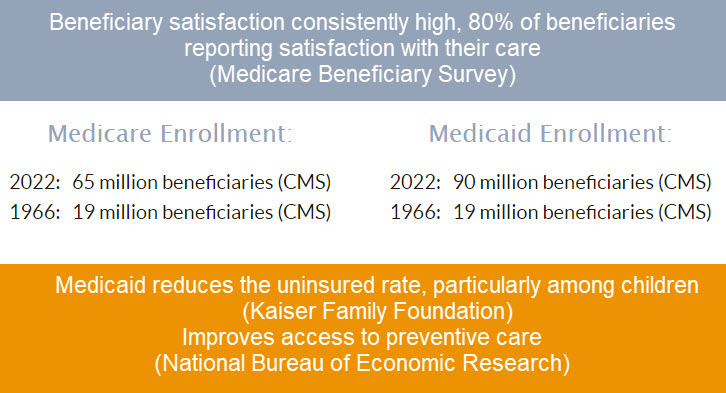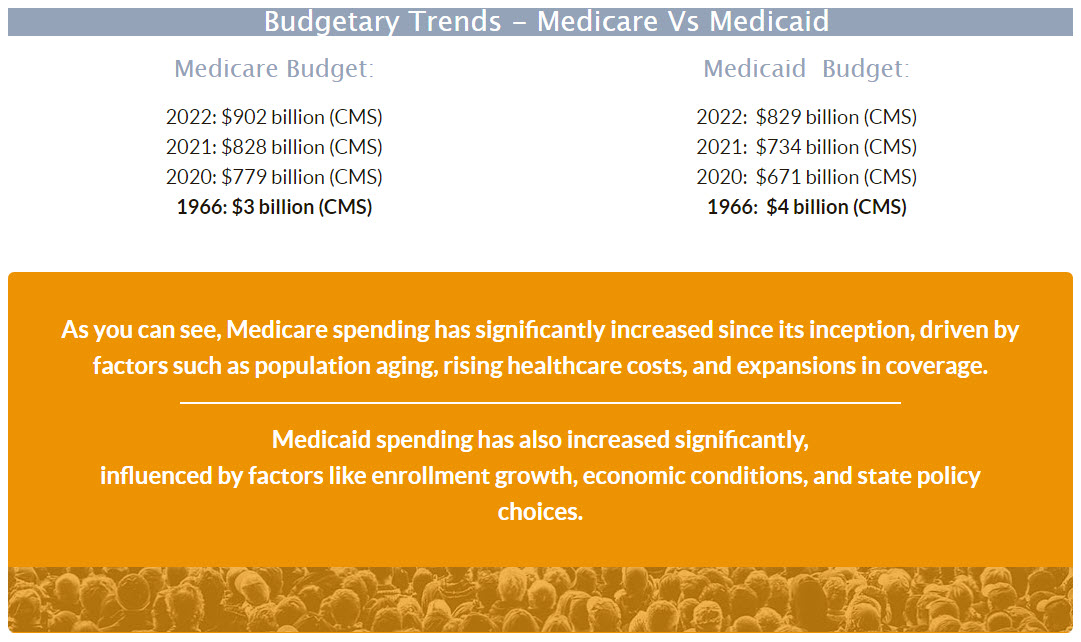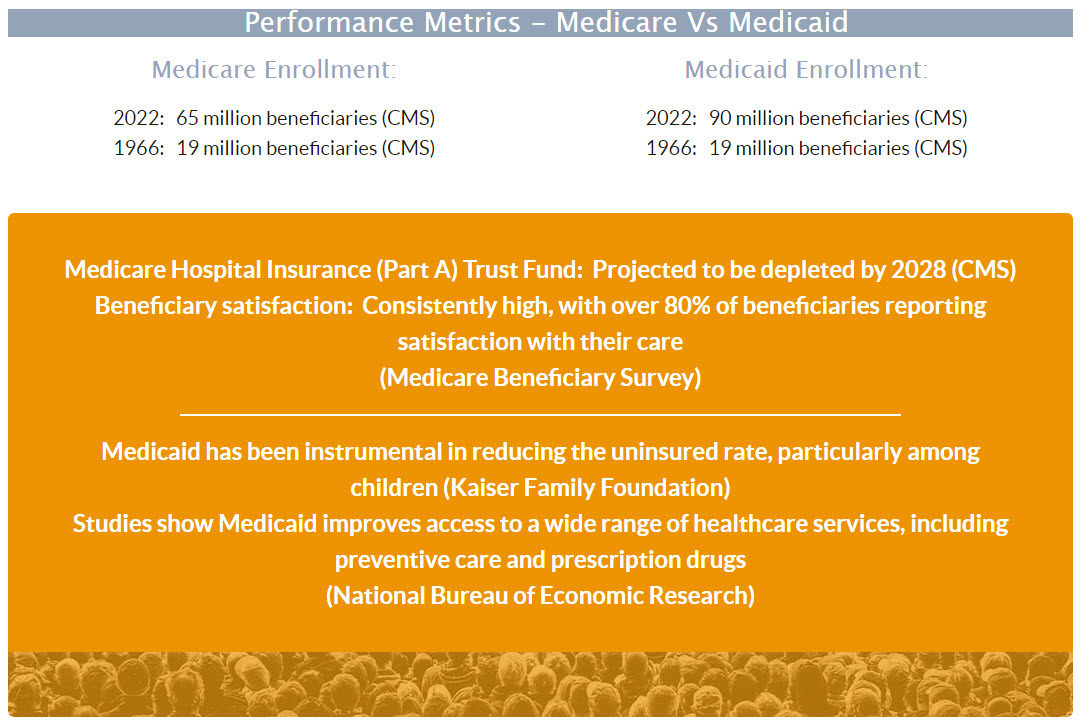Medicare vs Medicaid

We throw around terms like Medicare vs Medicaid in discussions about healthcare, and who should pay for it. Preventive care and wellness, aside, can we agree that
the need for healthcare is universal? Regardless of age, income, or social standing, everyone faces the risk of illness or injury. This shared vulnerability demands the supply for medical care.
And, if the cost of healthcare denies access to medical care? Now this would be the point at which we enter the public policy debate on who provides the healthcare, and who pays for it. Except . . .
the old guy writing this article won't go there. Not in this article. Not for you, the Adamsson Associate. All I really want to do is ask,
"What are these programs, Medicare and Medicaid, really about?"
In answering those most basic questions, I hope to, simultaneously, illuminate the financial load our government bears in supporting these programs and, then, encourage you and the work you do.
Be inspired, Adamsson Associate, when you help employers provide employee benefits. I want you to feel good about that. And motivated. Inspired. Perhaps, patriotic, even! Because, Adamsson Associate,
when you field underwrite insurance for business owners to recruit, reward, and retain their
best people, you're not only taking a load off of their shoulders,
you are lightening a load the government would, otherwise, be bearing.
So, what is Medicare vs Medicaid, exactly?
Q: Why would a business owner buy long term care insurance,
when the business could buy it for them?

Yours, with our thanks for answering 2 quick LTC questions.
Two Distinct Branches: Medicare vs Medicaid Emerge

From the fundamental need for healthcare in America, two distinct branches of the U.S. healthcare safety net arise: Medicare and Medicaid. Though their names sound similar, their purposes, eligibility criteria, and funding mechanisms differ significantly.
1. Medicare: Earned Access for Seniors and Specific Groups
2. Medicaid: A Safety Net for Low-Income Individuals and Families
Medicare
A brief history: Medicare, established in 1965 under President Lyndon B. Johnson, was designed to provide health insurance coverage to Americans aged 65 and older, regardless of income or medical history. This landmark legislation arose from the recognition that senior citizens faced significant financial barriers to healthcare access. Over the years, Medicare has expanded to cover individuals under 65 with certain disabilities and those with end-stage renal disease.
Medicare embodies the principle of earned access. It recognizes that individuals who have contributed to society through years of work deserve healthcare coverage in their later years.
Primarily, you become eligible for Medicare at age 65 if you or your spouse paid Medicare taxes for at least 10 years.
Certain younger individuals with disabilities or end-stage renal disease also qualify.
Medicare is primarily funded through payroll taxes, premiums paid by beneficiaries, and general tax revenues. This shared responsibility reflects the program's social insurance model.
Medicare is structured around four parts:
· Part A (Hospital Insurance): Covers inpatient hospital stays, skilled nursing facility care, and some home health services.
· Part B (Medical Insurance): Covers doctor's visits, outpatient care, preventive services, and medical equipment.
· Part C (Medicare Advantage): Offers an alternative way to receive Medicare benefits through private insurance plans.
· Part D (Prescription Drug Coverage): Provides subsidized access to prescription medications.
Budget: Medicare spending has steadily increased over the years, driven by factors such as population aging, rising healthcare costs, and expansions in coverage.
Performance: Medicare has been successful in expanding health insurance coverage to millions of seniors and individuals with disabilities. Key performance indicators include:
- Increased access to care: Medicare beneficiaries have high rates of access to primary and preventive care services.
- Improved health outcomes: Studies have shown that Medicare has contributed to significant improvements in health outcomes for seniors, including reduced mortality rates.
- Beneficiary satisfaction: Medicare beneficiaries generally report high levels of satisfaction with the program.
Medicaid
A brief history: Medicaid, also enacted in 1965, is a joint federal and state program providing health coverage to eligible low-income individuals and families, including pregnant women, children, and people with disabilities. Medicaid plays a crucial role in ensuring access to essential healthcare services for vulnerable populations.
Medicaid embodies the principle of need-based assistance. It aims to ensure that individuals and families with limited financial resources can still access essential healthcare.
· Eligibility: Medicaid eligibility varies by state but generally extends to low-income individuals, families with children, pregnant women, and people with disabilities.
· Funding: Again, Medicaid is jointly funded by the federal government and individual states. This shared financial responsibility allows states to tailor their programs to meet the specific needs of their residents.
· Key Features: Medicaid provides comprehensive coverage, including doctor's visits, hospital stays, preventive care, long-term care, and prescription drugs.
Budget: Medicaid spending is influenced by factors such as enrollment growth, economic conditions, and state policy choices.
Performance: Medicaid plays a vital role in providing healthcare access to low-income Americans. Key performance indicators include:
- Reduced uninsured rates: Medicaid has been instrumental in reducing the number of uninsured individuals and families.
- Improved access to care: Medicaid beneficiaries have improved access to a wide range of healthcare services, including preventive care, hospital care, and long-term care.
- Health disparities: Medicaid has helped to reduce health disparities between low-income and higher-income Americans.


Mapping the Connections: Medicare and Medicaid Can Intersect
While distinct, Medicare vs Medicaid are not mutually exclusive. Some individuals qualify for both programs, known as "dual eligibility." This often applies to low-income seniors or individuals with disabilities.
Medicare and Medicaid represent two pillars of the U.S. healthcare safety net, each rooted in distinct principles and serving different populations. Those principles for Medicare being increased access to healthcare, improved outcomes, and beneficiary satisfaction.
On the Medicaid side, the principles are reduced uninsured rates, improved access to care, reduced health disparities due to an American's economic status.
Understanding these foundational differences is crucial for
navigating the complexities of the American healthcare system.
Sources:
Centers for Medicare & Medicaid Services (CMS). CMS.gov. U.S. Department of Health & Human Services, CMS.gov. Accessed 17 Oct. 2023.
Kaiser Family Foundation. State Health Facts. Kaiser Family Foundation, www.kff.org. Accessed 17 Oct. 2023.
National Bureau of Economic Research (NBER). NBER. www.nber.org. Accessed 17 Oct. 2023.
Medicare Beneficiary Survey. Medicare.gov. U.S. Department of Health & Human Services, Medicare.gov. Accessed 17 Oct. 2023.
SSA.gov. U.S. Social Security Administration, n.d. Web. \ October 14, 2024.
